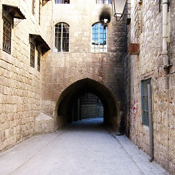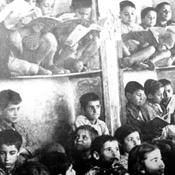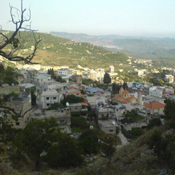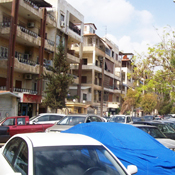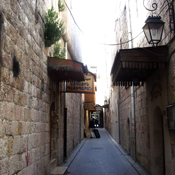The Armenians in Syria are Syrian citizens of either full or partial Armenian descent.
Syria and the surrounding areas have often served as a refuge for Armenians who fled from wars and persecutions such as the Armenian Genocide. According to Armenian diaspora organizations estimated that there are 150,000 Armenians in Syria, most of whom live in Aleppo. But in fact the number of the Armenian population in Syria has declined during the recent 20 years, and it roughly counts 100,000 nowadays. The town of Kesab has an Armenian majority.
The Armenian-speaking Mushkas (founders of Armenian ethnicity) who migrated from Europe are thought to have migrated through south-east modern Turkey close to the territory of modern Syria. An early 17th century narrow alley in Jdeydeh, leading to the old Armenian quarter of Hokedun, Aleppo Armenia under Tigranes the Great subjugated Syria, and chose Antioch as one of the four capitals of the short lived Armenian Empire. During Antiquity, there was some Armenian presence in Northern Syria, however it wasn’t a considerable one.
Christianity became the official religion of Armenia in 301 through the efforts of Saint Gregory the Illuminator. Armenian merchants and travelers often frequented Antioch, one of the earliest sites of Christian teaching and practice, and had relations with the even closer Christian centers of Edessa and Nisibis, all of which are located in Greater Syria, where Christianity flourished in apostolic times.
When the Seljuk Turks conquered Armenia from its previous Byzantine rulers, waves of Armenians left their homeland in order to find a more stable place to live. Most Armenians established themselves in Cilicia where an Armenian kingdom was founded, but some chose Northern Syria. Armenian quarters were formed during the 11th century in towns or cities such as Antioch, Aleppo, Aintab, etc.
During the Crusades, the Armenian Kingdom of Cilicia chose to side with the European invaders rather than the mostly Turkish rulers of Syria. Prior to the Siege of Antioch, most Armenians were expelled from Antioch by Yaghi-Siyan, the Turkish governor of the city, a move that prompted the Armenians of Antioch to show further support to the Crusaders. Thus, the new rulers of Antioch became the Europeans. Armenian engineers also helped the Crusaders during the Siege of Tyre by manipulating siege engines. The Armenian population of Syria and its surrounding areas greatly diminished after the region was taken by the Mongols under Hulagu.
At the beginning of the 14th century, a new wave of Armenian migrants from Cilicia arrived in Aleppo with the decline of the Armenian Kingdom of Cilicia. They have gradually developed their own schools, churches and later on the prelacy, to become a well-organized community during in Aleppo by mid-14th century. At the first years of the Ottoman rule, there was relatively smaller Armenian presence in Northern Syria due to the previous conflicts. A larger community existed in Urfa, a city often considered part of Greater Syria.
The Ottoman Empire had a large indigenous Armenian population in its Eastern Anatolia region, from where some Armenians moved to Aleppo in search of economic opportunity. Later on, many Armenian families moved from Western Armenia to Aleppo escaping the Turkish oppression. Thus, large numbers of Armenians from Arapgir, Sasun, Hromgla, Zeitun, Marash and New Julfa arrived in Aleppo during the 17th century. Another wave of migrants from Karin arrived in Aleppo in 1737. There were also families from Yerevan.
Armenians in Syria (20th century-Present)
Although the Armenians have had a long history in Syria, most arrived there during the Armenian Genocide committed by the Ottoman Empire. The main killing fields of Armenians were located in the Syrian desert of Deir ez-Zor (Euphrates Valley). 1.5 million Armenians were killed and hundreds of thousands fled historic Armenia. The native Arabs didn’t hesitate to shelter and support persecuted Armenians. Arabs and Armenians have traditionally had good relations after Arabs sheltered the Armenians during the Armenian Genocide. There was also a minor Arab genocide in Anatolia at the same time.
Most Armenians of Syria live in Aleppo, while a smaller community exists in the capital city of Damascus. Armenians even have their own quarter “Hayy al Arman” (Quarter of the Armenians) in Damascus.
There are Armenians also in Latakia, Kesab and Yacoubiyah in the northwest, and in Ar-Raqqah, Tal Abyad, Al-Hasakah, Qamishli, Al-Malikiyah and Ra’s al-‘Ayn in the east.
Kesab, an Armenian Town in Syria
Kesab is a Syrian border town located in Latakia Governorate northwest of Syria at a height of 800 meters above sea level just 3 kilometers away from the Turkish border, and 9 kilometers from the Mediterranean sea. Kesab is an ancient Armenian town, over 1000 years old. Today, The population of the town and the surrounding villages is mainly Armenian with a minority of Syrian Arab. Kesab is a touristic summer resort and a very popular destination.
Deir ez-Zor and the Armenian Genocide
In 1915, the Syrian region of Deir ez-Zor, mainly a desert became a final destination of the Armenians during Armenian Genocide where they were killed. A memorial complex commemorating this tragedy was opened in the city. It was designed by Sarkis Balmanoukian and was officially inaugurated in 1990 with the presence of the Armenian Catholicos of the Great House of Cilicia. The complex contains bones and remnants recovered from the Deir ez-Zor desert of Armenian victims of the Genocide and has become a pilgrim destination for many Armenians in remembrance of their dead.
Source: Armenians in Syria | From Wikipedia, the free encyclopedia

